Human Rights Day Essay: Simple Guide for Students
Celebrating Freedom, Equality, and Dignity for A
Introduction: Human Rights Day – Why It Matters
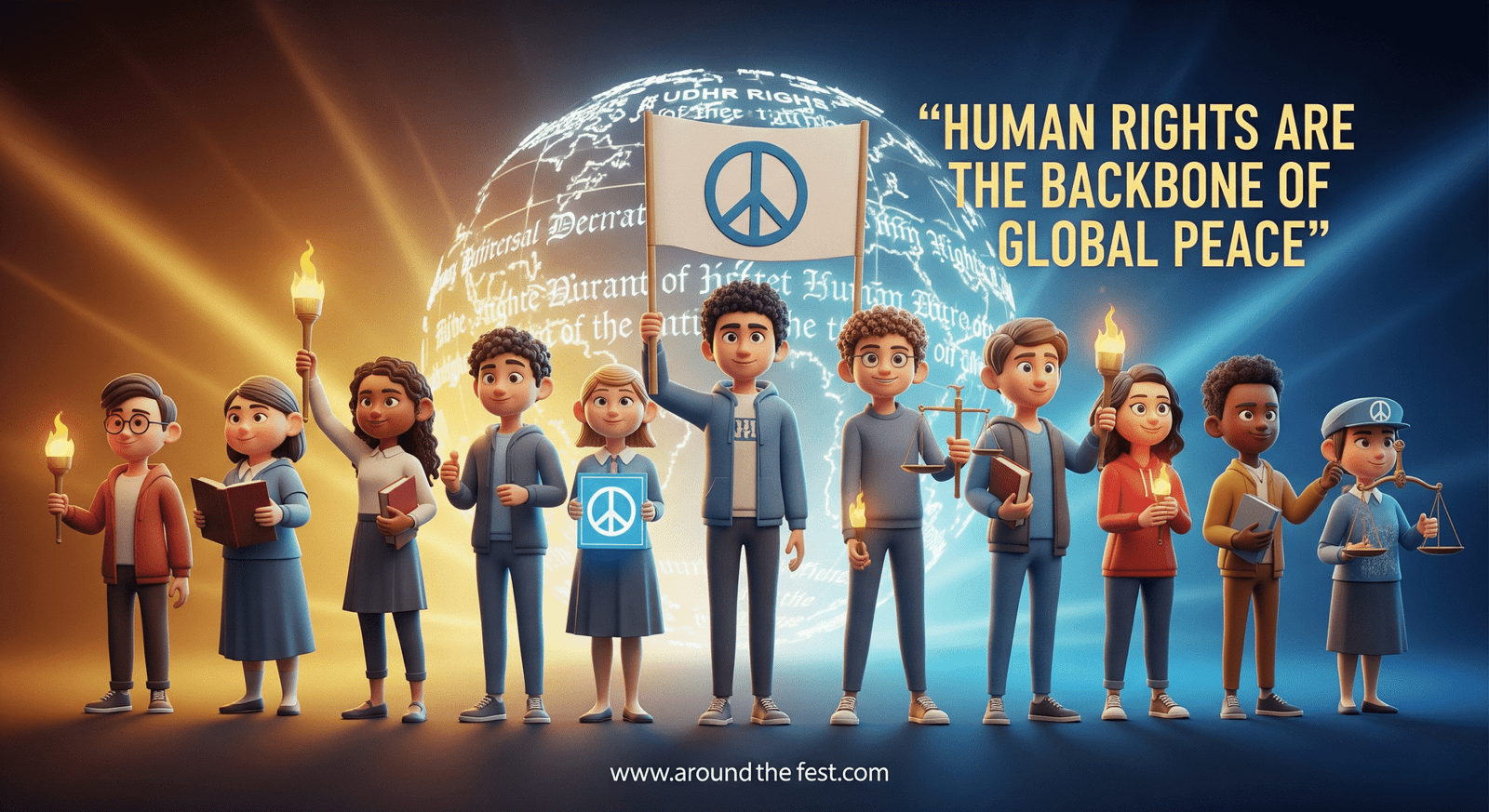
Human Rights Day Essay for students explores why every individual deserves freedom, equality, and dignity. This highlights that all people should live free from fear, discrimination, and oppression. Throughout history, millions have been denied these basic rights due to wars, slavery, colonization, and social inequality.
The Universal Declaration of Human Rights (UDHR), adopted by the United Nations on December 10, 1948, marked a historic step toward global equality and justice. Human Rights Day reminds students and communities that protecting human rights is not only a legal duty but a moral responsibility. This essay explains how students can become active defenders of human rights, promoting fairness, equality, and dignity in their schools and communities.
“To deny people their human rights is to challenge their very humanity.” — Nelson Mandela
Thesis Statement: This Human Rights Day Essay demonstrates the importance of human rights, traces their history, highlights current challenges, and shows how students can play a key role in advancing justice and equality.
What Is Human Rights Day?
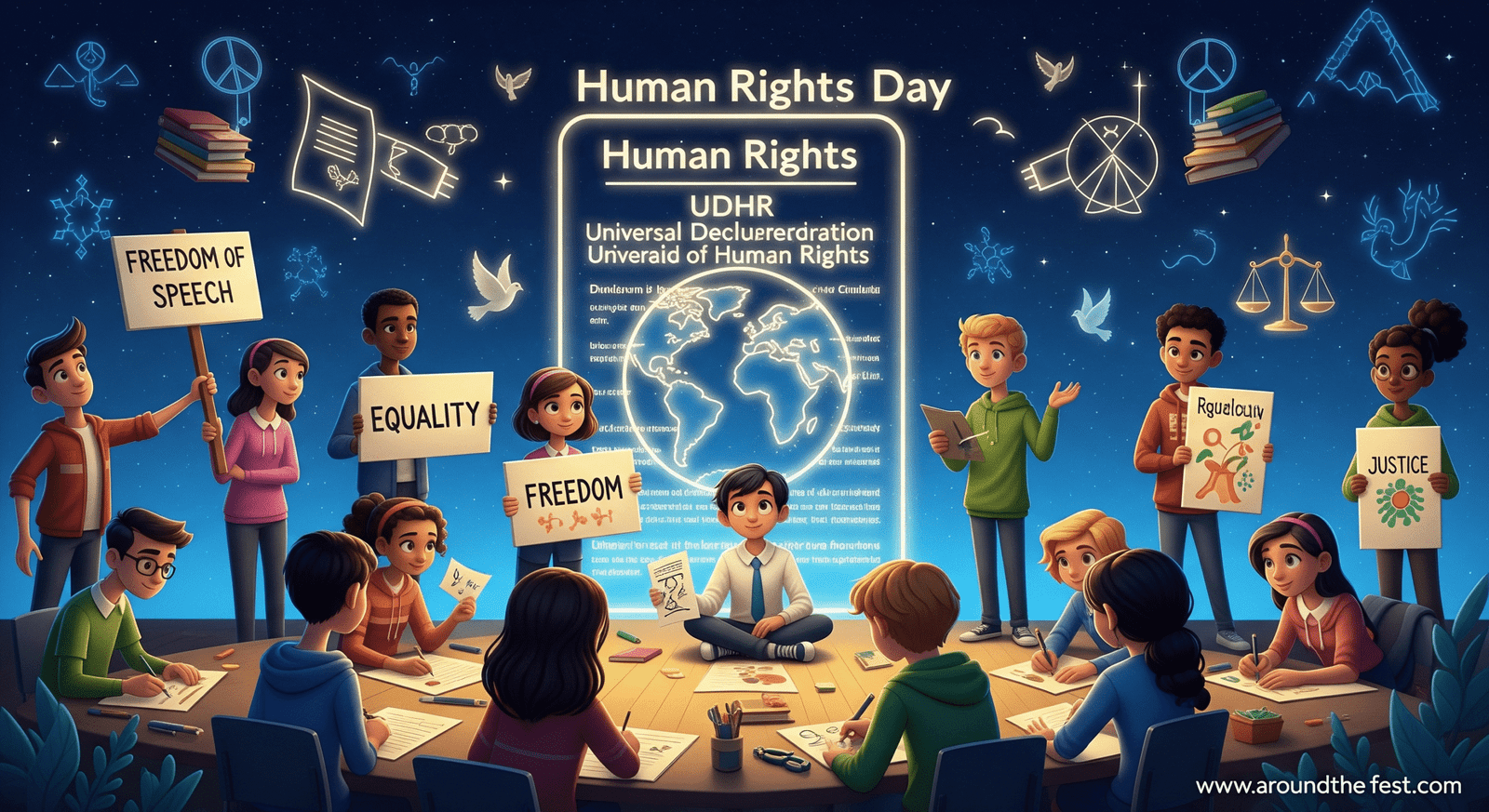
Human Rights Day commemorates the adoption of the UDHR, a landmark document that establishes universal human rights for all. This Human Rights Day Essay explains why this day is celebrated and how it encourages students to understand the value of equality and justice.
The UDHR contains 30 articles outlining rights such as freedom of speech, religion, education, and protection from discrimination and violence. Each year, the United Nations selects a theme highlighting contemporary issues, including equality, digital freedom, or environmental justice.
Celebrating Human Rights Day helps students and communities to:
- Understand the importance of human rights.
- Promote action against injustice and discrimination.
- Encourage equality, peace, and inclusion in schools and society.
Students can participate in discussions, workshops, art projects, essay competitions, or social media campaigns to raise awareness about local and global human rights issues. By connecting these activities with real-world challenges, students make the principles of the UDHR meaningful and practical.
A Detailed History of Human Rights Day
Human rights have evolved over centuries through struggle, advocacy, and reform. This Human Rights Day Essay examines major milestones in human rights history:
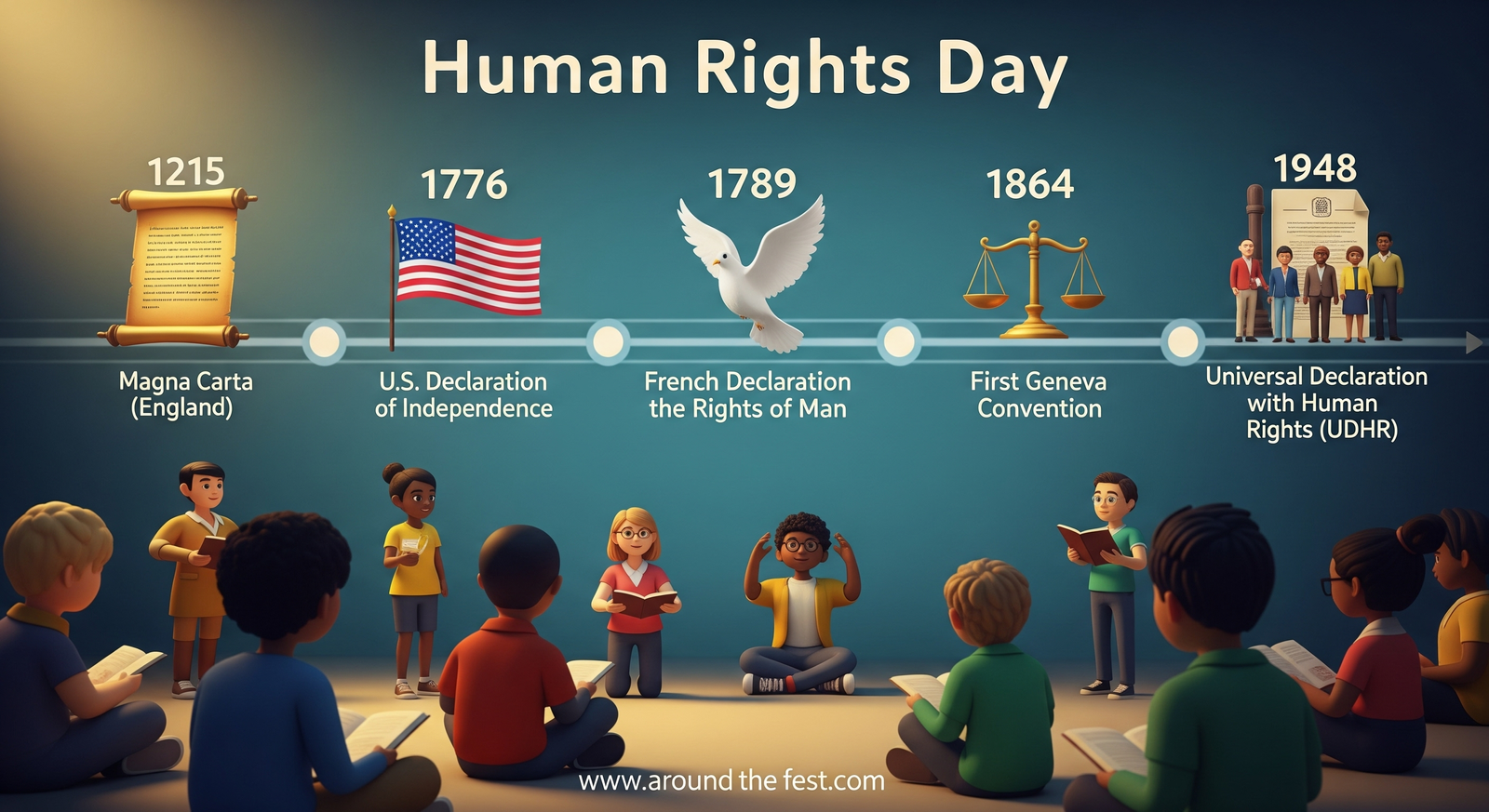
1215 – Magna Carta (England): Introduced the principle that rulers must obey the law and respect individual rights.
1776 – U.S. Declaration of Independence: Declared all men are created equal and entitled to life, liberty, and the pursuit of happiness.
1789 – French Declaration of the Rights of Man: Promoted liberty, equality, and fraternity, emphasizing citizen participation.
1864 – First Geneva Convention: Provided humanitarian protections for war victims.
1948 – Universal Declaration of Human Rights: Established global standards for human rights.
Other important milestones include:
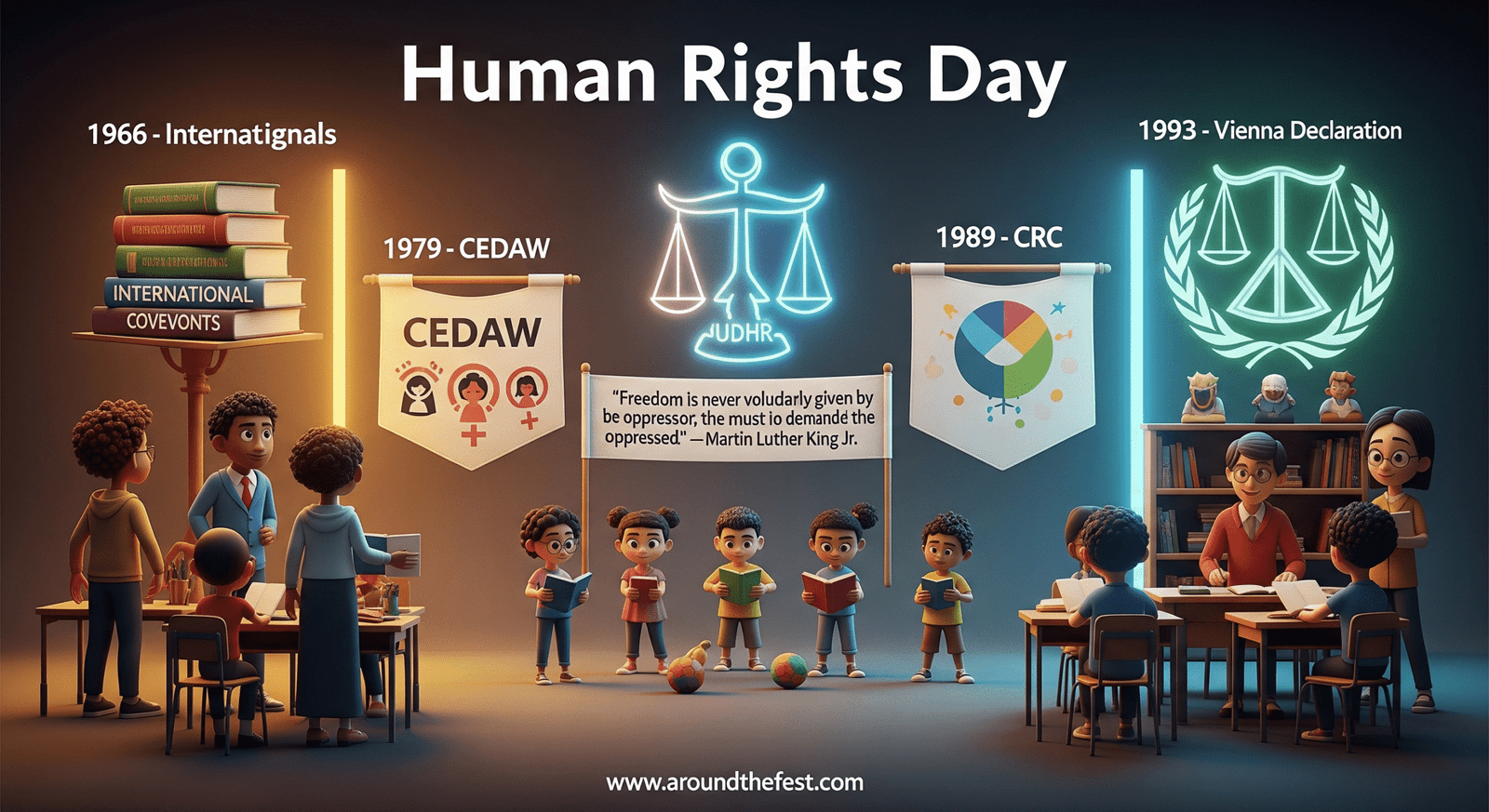
1966 – International Covenants on Civil, Political, Economic, Social, and Cultural Rights: Legally binding protections for human rights.
1979 – Convention on the Elimination of All Forms of Discrimination Against Women (CEDAW): Focused on gender equality.
1989 – Convention on the Rights of the Child (CRC): Guaranteed children’s rights globally.
1993 – Vienna Declaration: Reaffirmed universality and emphasized education as a tool for human rights awareness.
“Freedom is never voluntarily given by the oppressor; it must be demanded by the oppressed.” — Martin Luther King Jr.
Understanding this history shows students that human rights are achievements of struggle and advocacy, and that defending them is an ongoing responsibility.
Importance of Human Rights Day Today
why human rights are essential in contemporary society:
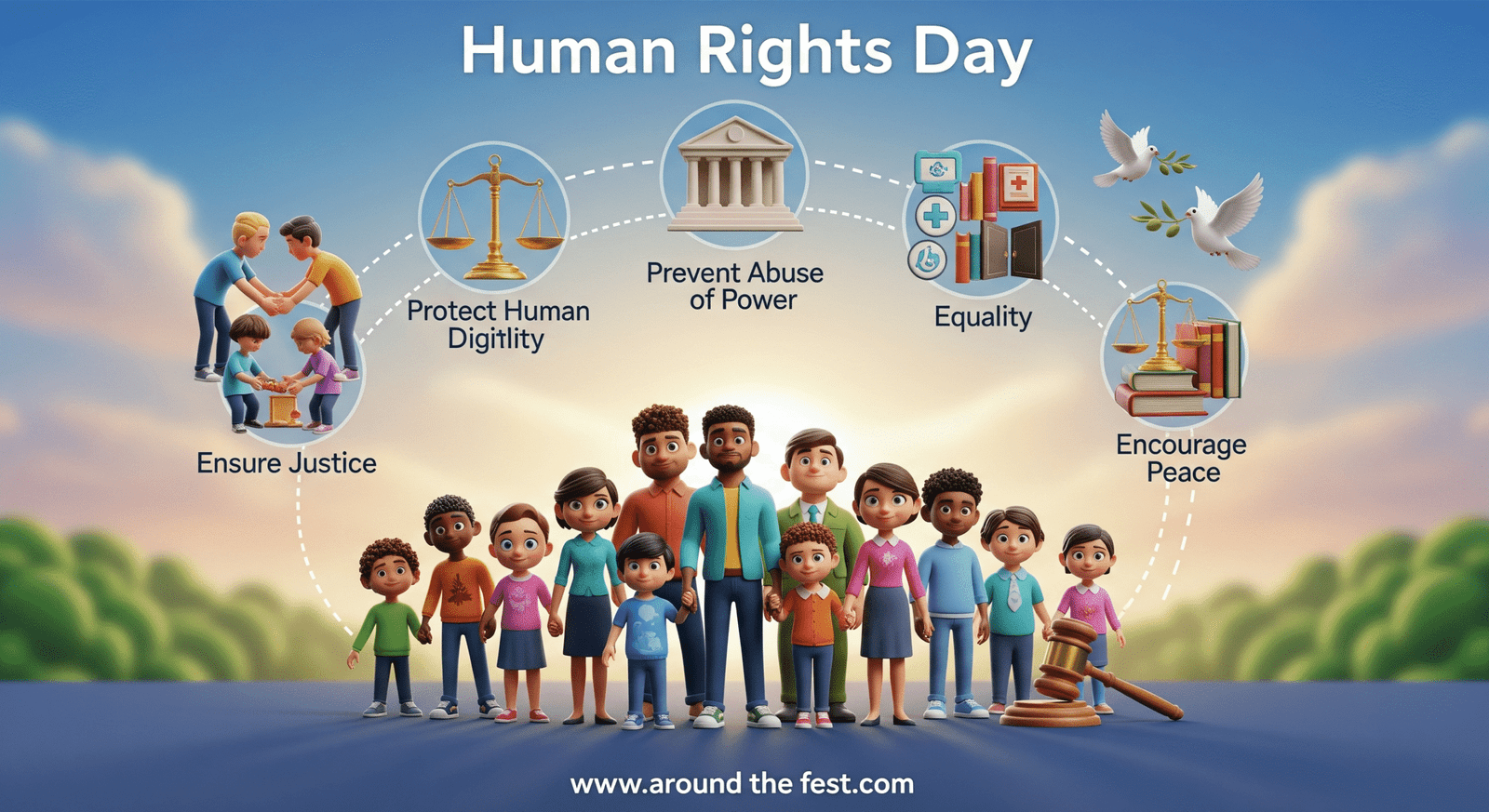
Protect Human Dignity: Everyone deserves respect, regardless of background.
Prevent Abuse of Power: Governments and individuals must be accountable.
Promote Equality: Everyone should have access to education, healthcare, and opportunities.
Ensure Justice: Legal systems protect individuals from unfair treatment.
Encourage Peace: Rights-respecting societies are less prone to conflict.
Statistics:
Over 260 million children worldwide are out of school (UNICEF).
1 in 3 women globally experiences gender-based violence (WHO).
80 million people are displaced due to conflict and persecution (UNHCR).
Students can take these principles to heart by promoting respect, standing up for peers, and advocating for fair policies in their schools and communities.
Themes and Messages of Human Rights Day
Every year, Human Rights Day has a theme reflecting global priorities:
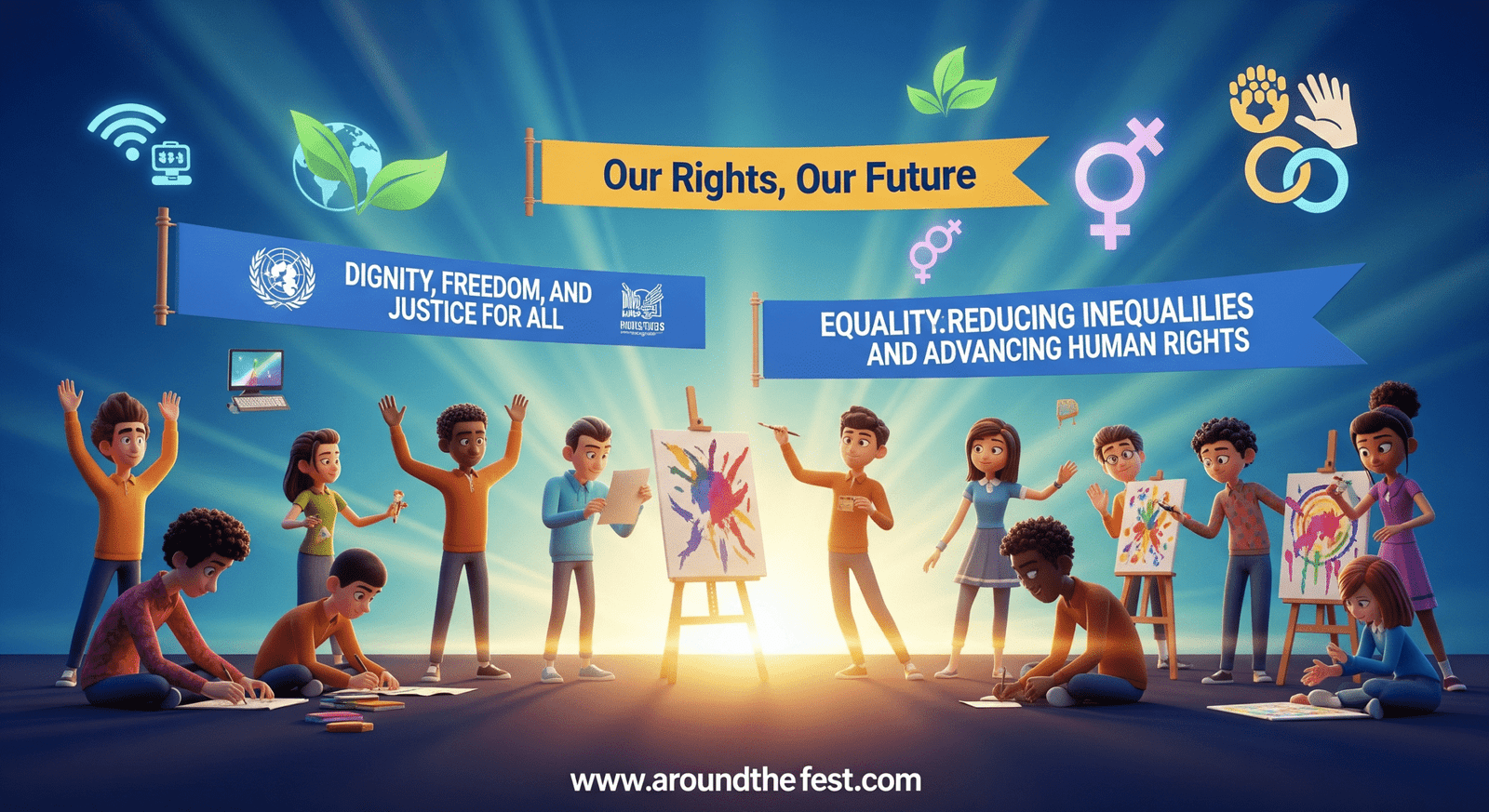
- “Dignity, Freedom, and Justice for All” – core human rights values
- “Our Rights, Our Future” – youth empowerment
- “Equality: Reducing Inequalities and Advancing Human Rights” – addressing wealth, education, and opportunity gaps
Modern themes also cover digital freedom, climate justice, gender equality, and minority rights, emphasizing that human rights evolve with society. Students can explore these themes through essays, school projects, debates, and art exhibitions, connecting classroom learning with global challenges.
Challenges to Human Rights Day
Even today, human rights face significant challenges:
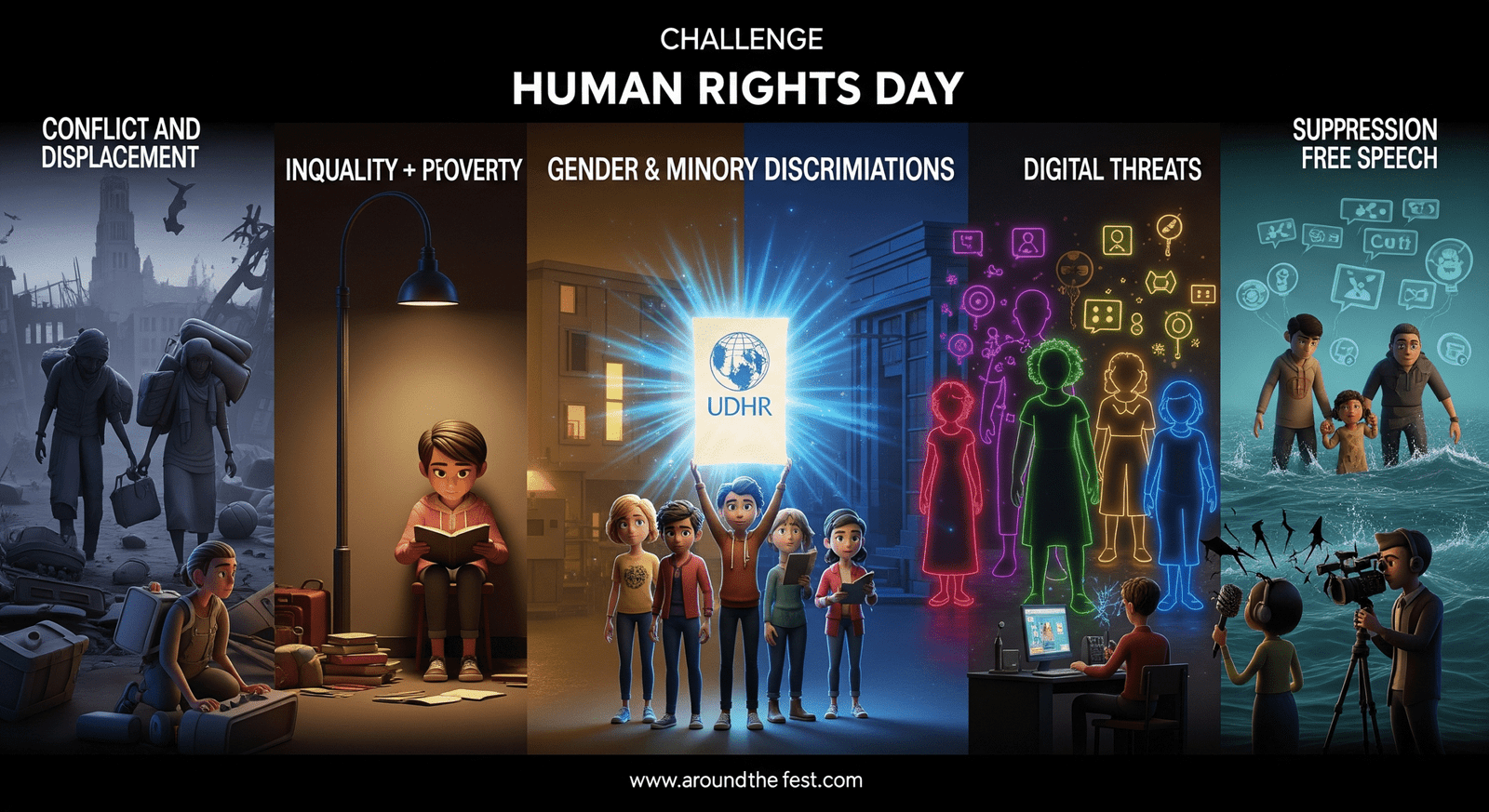
Conflict and Displacement: Wars and persecution have created millions of refugees.
Inequality and Poverty: Millions still lack access to education, healthcare, and housing.
Climate Change: Extreme weather disproportionately affects vulnerable communities.
Gender and Minority Discrimination: Systemic inequality continues worldwide.
Digital Threats: Online harassment, surveillance, and misinformation violate privacy.
Suppression of Free Speech: Journalists, activists, and students often face intimidation.
This Human Rights Day Essay encourages students to propose solutions, raise awareness, and engage in advocacy to combat these issues.
Role of Students in Human Rights Day
Students are powerful agents of change. This Human Rights Day Essay highlights how youth can contribute:
- Learn and Educate: Classroom discussions, workshops, and peer mentoring.
- Speak Up: Challenge bullying, discrimination, and unfair treatment.
- Use Technology Responsibly: Share accurate information and advocate online.
- Volunteer: Support NGOs and community initiatives.
- Engage in Governance: Join student councils and advocacy forums.
“Never doubt that a small group of thoughtful, committed citizens can change the world; indeed, it’s the only thing that ever has.” — Margaret Mead
School activities like essay competitions, art exhibitions, and social media campaigns provide practical ways for students to celebrate and defend human rights.
Global Celebrations and Initiatives
Human Rights Day is observed worldwide with educational, cultural, and advocacy events:
UN Conferences: Discuss global policies and education programs.
School Activities: Debates, speeches, exhibitions, and awareness campaigns.
NGO Campaigns: Focus on women’s rights, child protection, climate justice.
Cultural Festivals: Celebrate diversity and inclusion.
Social Media Campaigns: Hashtags like #HumanRightsDay and #StandUp4HumanRights reach millions.
Students can engage in local, national, or virtual campaigns to connect with the global human rights movement.
Inspiring Human Rights Success Stories
- Malala Yousafzai: Advocates for girls’ education.
- Nelson Mandela: Led South Africa against apartheid.
- Greta Thunberg: Youth activism for climate justice.
- Doctors Without Borders (MSF): Provides humanitarian aid.
- Rosa Parks: Sparked civil rights movements through peaceful protest.
These examples show that individual courage combined with community action can create global change.
Practical Ways Students Can Make a Difference
Students can translate learning into action:
- Organize awareness campaigns in schools and communities.
- Volunteer with local NGOs or refugee programs.
- Conduct research and create essays, posters, or videos.
- Participate in international youth forums or competitions.
- Advocate for inclusive curricula, anti-bullying policies, and fair representation.
“Act as if what you do makes a difference. It does.” — William James
The Way Forward – Conclusion
Protecting human rights requires integration into daily life:
Governments: Enforce laws and punish violations.
Media: Promote transparency and truth.
Schools: Teach empathy, equality, and civic responsibility.
Individuals: Practice respect, fairness, and kindness daily.
it is not just a date; it is a call to action. Students can continue the legacy through education, advocacy, and community service. By promoting equality and standing against injustice, students ensure that human rights are more than words—they become reality.
“Human rights are the first step toward building a better world, and students are the torchbearers of this change.” — Kofi Annan
Also read-https://aroundthefest.com/international-human-rights-day-2025-date-theme-celebrations/
FAQ – Human Rights Day
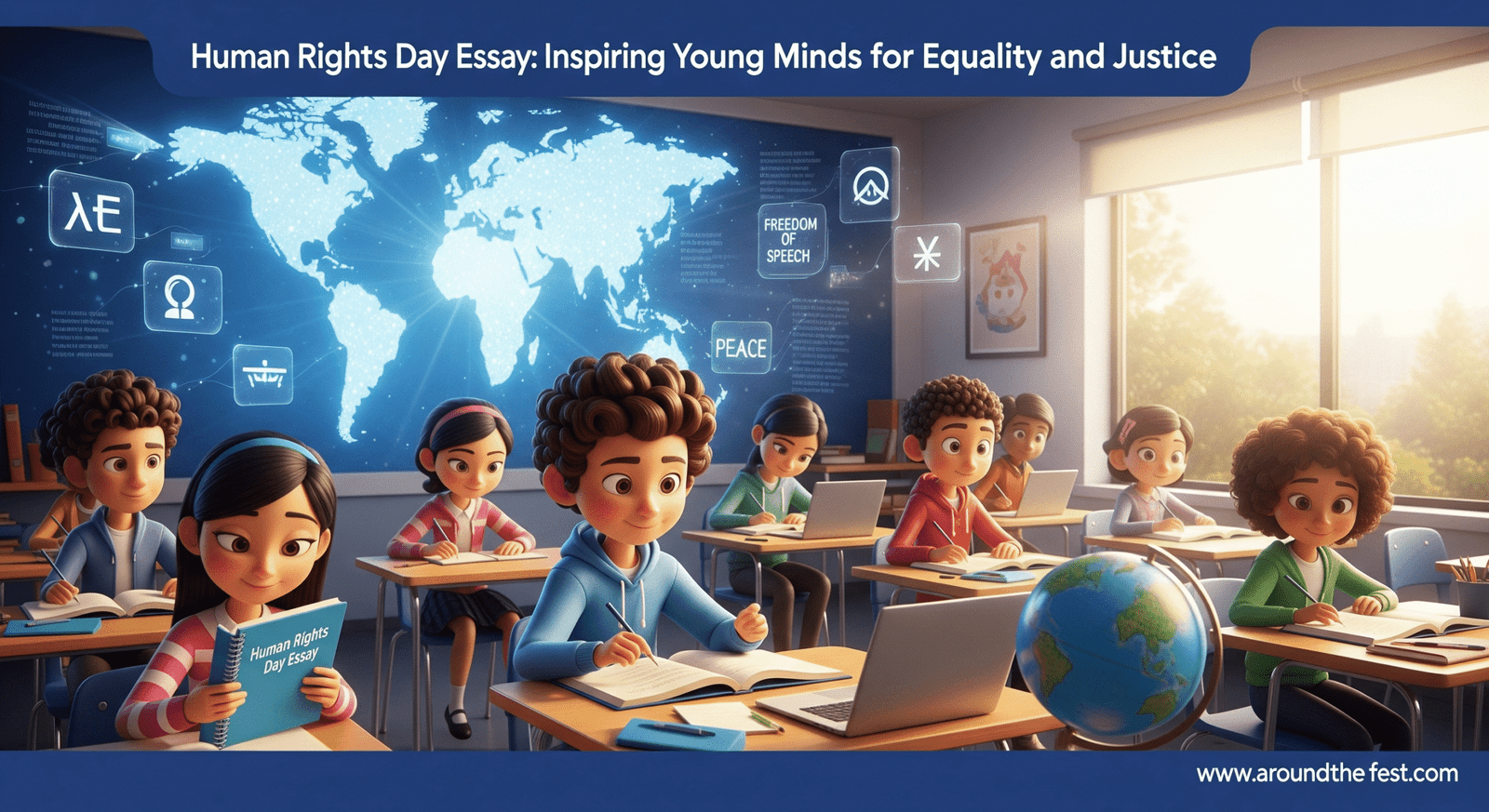
Q1: Why is Human Rights Day important for students?
A: It teaches students to understand their rights, respect others, and actively promote fairness and justice.
Q2: How can students celebrate Human Rights Day?
A: Through debates, essay competitions, art projects, volunteering, and social media awareness campaigns.
Q3: Who are inspiring human rights leaders?
A: Malala Yousafzai, Nelson Mandela, Rosa Parks, Greta Thunberg, and NGOs like Doctors Without Borders.
Q4: What are common challenges today?
A: Conflicts, inequality, climate change, gender and minority discrimination, digital threats, and suppression of free speech.
Q5: How can students make a difference?
A: By learning, raising awareness, volunteering, advocating, and promoting a culture of respect and empathy.
Human rights day essay 250 words for students in english
Human Rights Day Essay for Students highlights why every individual deserves freedom, equality, and dignity. Every person should live free from fear, discrimination, and oppression, yet history has witnessed countless violations due to wars, slavery, colonization, and social inequality. To address these challenges, the United Nations adopted the Universal Declaration of Human Rights (UDHR) on December 10, 1948. Human Rights Day reminds students that protecting human rights is both a legal obligation and a moral responsibility.
Human rights ensure respect for human dignity, equality, justice, and freedom. They protect individuals from abuse, promote fairness, and inspire peace. While progress has been made, challenges such as conflict, poverty, discrimination, climate change, and digital threats still threaten basic rights worldwide.
Students play a crucial role in advancing human rights. They can learn and educate others, speak up against injustice, volunteer, and use technology responsibly to raise awareness. School activities like debates, essay competitions, art projects, and social media campaigns provide practical ways for students to actively promote human rights.
Human Rights Day also celebrates inspiring figures like Malala Yousafzai, Nelson Mandela, Greta Thunberg, and organizations like Doctors Without Borders, showing that one person or group can make a global impact.
In conclusion, Human Rights Day Essay for Students emphasizes that defending human rights is everyone’s responsibility. By standing up for fairness, equality, and justice, students can help build a world where freedom and dignity are realities for all.
Human rights day Essay 150 words
Human Rights Essay for Students explains why every individual deserves freedom, equality, and dignity. All people should live without fear, discrimination, or oppression, yet history has seen violations through wars, slavery, and social inequality. The Universal Declaration of Human Rights (UDHR), adopted by the United Nations on December 10, 1948, set global standards to protect these rights.
Human rights ensure respect for human dignity, equality, justice, and freedom. They protect individuals from abuse, promote fairness, and inspire peaceful societies. Challenges like conflict, poverty, discrimination, and climate threats still exist, making awareness crucial.
Students can play an important role by learning about rights, raising awareness, speaking against injustice, and volunteering. Inspiring leaders like Malala Yousafzai, Nelson Mandela, and organizations like Doctors Without Borders demonstrate how individuals can create global impact.
In conclusion, Human Rights Essay for Students emphasizes that defending human rights is a responsibility for everyone. Students can help build a fair and just world.

